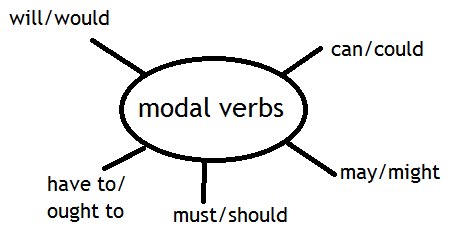
SPC-ELL: Modal Auxiliary Verbs
Self-Paced Collection of English Language Lessons
Make sure you "allow" blocked content and turn your speakers on to use this SoftChalk lesson. Watch the videos, listen to the recordings, and read the explanations on each page. Put your mouse over the bold words to read and see more. You can visit each page and try each activity as often as you want for practice.
When you want your answers to count, complete all activities and questions in order on each page, click "Check Answers" and then next page to continue.
Important - if you want to submit your scores, click Finish on the last page to submit your scores directly to your teacher.

At the end of this lesson, you should be able to:
1. Use correct grammar with modals
2. Choose the correct modal or phrasal modal for a variety of social situations
Click the play arrow above to listen.
Modal auxiliary verbs are helping verbs that are used to express feelings, attitudes, or opinions. Using modals, a speaker or writer can express that something is necessary or possible, strong or weak preferences, or they can use modals to give advice or permission. In addition, a speaker or writer can express varying degrees of certainty about an event or activity with modal verbs.
Let's look at some examples.
Note: for some modals, there is a "phrasal modal" equivalent - it has the same meaning:
|
1 Word Modal |
Phrasal Modal |
Example Sentences |
|---|---|---|
|
can |
be able to |
I can run really fast. I am able to run really fast. |
|
must |
have to |
You must do well on your next test! You have to do well on your next test! |
|
should |
ought to |
My doctor said I should eat healthier foods. My doctor said I ought to eat healthier foods. |

After you "test yourself," watch this video to learn more about basic grammar rules using modal auxiliary verbs.
(Note: the word "auxiliary" is not spelled correctly in the video.)
Click the play arrow above to listen.
|
Rule |
NO !!!!!!!!! |
YES :-) |
|---|---|---|
|
Don't add 3rd person final -s/-es to modals |
She cans see it. |
She can see it. |
|
Use the simple form of the main verb after a modal |
She can sees it. |
She can see it. |
|
Don't use the infinitive of the main verb with modals |
She can to see it. |
She can see it. |
|
There is no past tense of modals verbs (no -ed). Another modal must be used to express past tense. |
She caned see it yesterday. |
She could see it yesterday. |
Try this Sorting Activity to test your knowledge.
There is no past tense of modals verbs (no -ed form). Another modal must be used to express past tense.
Click the play arrow above to listen.
|
Meaning |
Modal |
Phrasal Modal |
Example Sentence |
|---|---|---|---|
|
Polite request or Permission |
can may could will would |
-- |
Can I play tennis? (informal) May I play tennis? Could I borrow your pen? Will you please help me? Would you please pass the salt? (very polite) |
|
Necessity |
must
|
have to have got to |
I must go to work tomorrow! I have to go to work tomorrow! I have got to work hard tomorrow! |
|
Advice or Suggestion |
could (weaker) should (stronger)
|
-- ought to had better (strongest) |
She could have chicken or fish for dinner. She should / ought to accept the invitation. She had better get to work on time today. |
|
Obligation or Expectation |
-- |
be supposed to |
Parents are supposed to take care of their children. She is supposed to come over to help me tonight. |
|
Ability |
can (present)
could (past) |
be able to (present or past) |
John can run fast. (present) John is / was able to run fast. John could run fast when he was a child. (past) |
|
Repeated actions in the past |
would |
used to |
My mother would read stories to me when I was young. My mother used to read stories to me when I was young. |
|
Degree of Certainty
Click here to watch a video about degrees of certainty with modals |
will (strongest) must should might may could (weakest) |
be going to -- ought to -- -- -- |
I will / am going to succeed if I try my best! (99-100%) The grass is wet. It must be raining. (95%) His plane should arrive at 9:00 pm. (90%) His plane might arrive at 9:00 pm. (<50%) We may see a movie tomorrow. (<50%) We could see a movie or go to the beach tomorrow. (<50%) |
After you study the list above, try the Drag N Drop Activity to test your knowledge.
Click the play arrow above to listen.
Must and have to both express a necessity or requirement when used in affirmative sentences. They have the same meaning although "must" is a little stronger and more formal than "have to."
For example:
When used in the negative, "must not" and "do not have to" have very different meanings. Look at these examples:
To Review
|
Affirmative |
Negative |
|---|---|
|
Must = necessity, requirement |
Must NOT = prohibition (not allowed) |
|
Have to = necessity, requirement |
Do NOT have to = lack of necessity (optional) |
Try this Sorting Activity and Quiz Group to check your understanding.

Click the play arrow above to listen.
May is used to make a polite request or give permission.
For example:
Remember: In a question, MAY can only be used with 1st person (May I, May we...?).
NEVER say: May you give me a ride home? May he come with us to the park?, etc.
Try this Quiz Group (Sorting Activity) to check your understanding.
Important - if you want to submit your scores, click Finish on the last page.
References: Azar, B. & Hagen, S., (2009). Understanding and Using English Grammar (4th Edition). White Plains, NY: Pearson Longman.